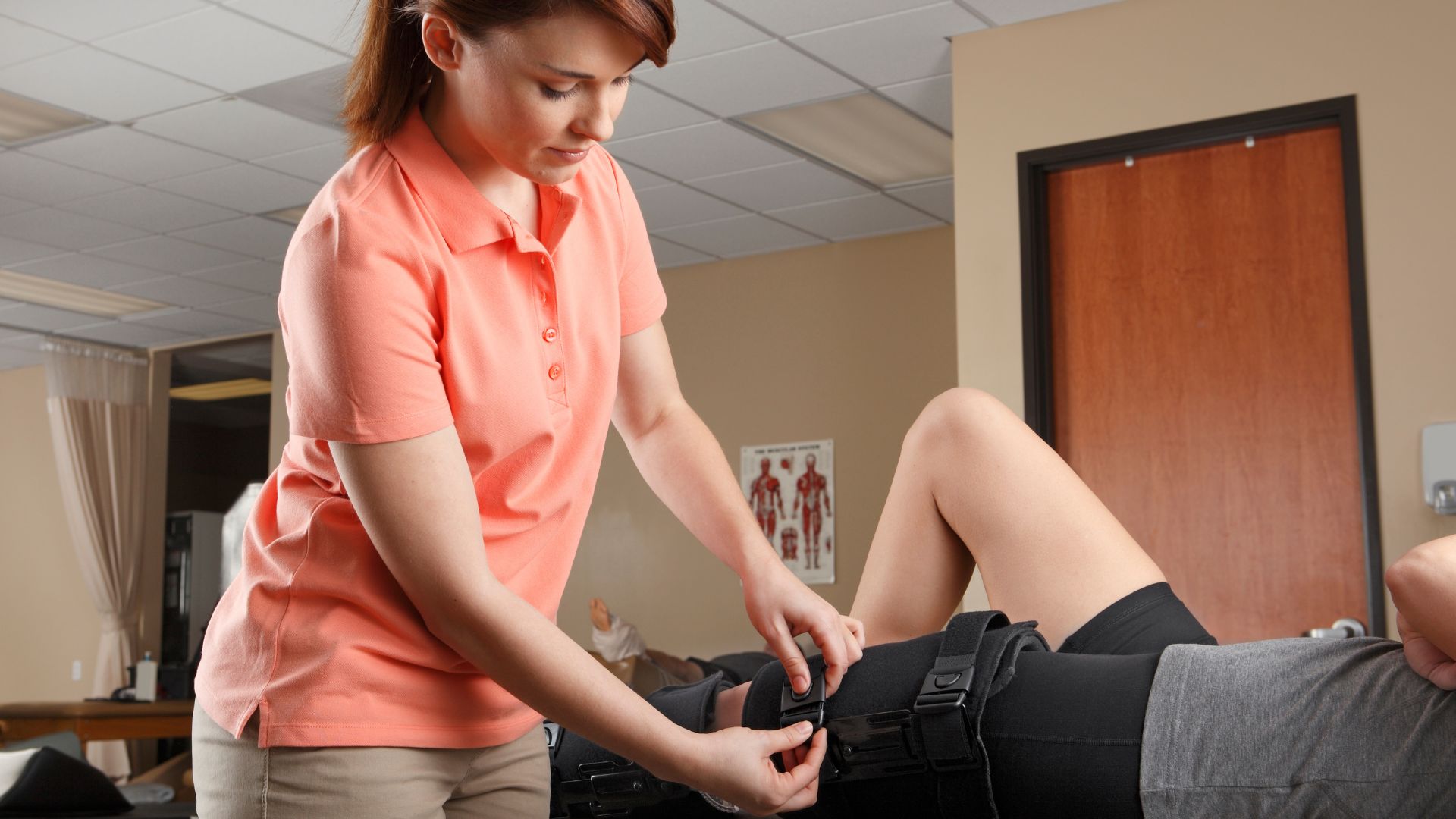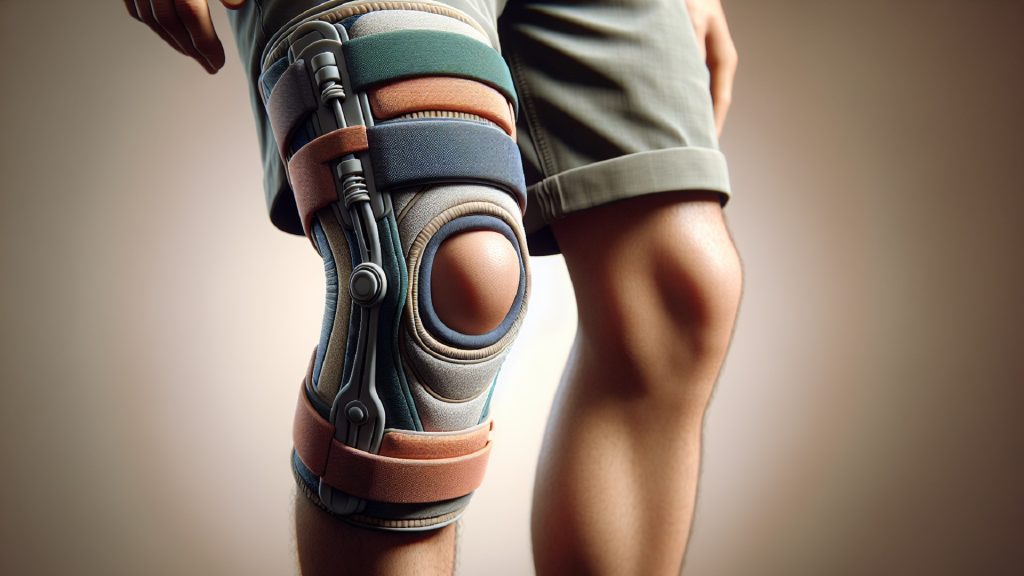Exploring knee brace and supports is key to understanding their differences. They are vital for knee health, whether you’re recovering from an injury or facing age-related issues. The right choice can significantly impact your knee’s stability and support.
Sarah, a 45-year-old marketing executive, loved her gym workouts. But during a session, she felt a sharp pain in her right knee. Despite the pain, she finished her workout, only to struggle the next day.
Sarah’s experience highlights the importance of knee care. In this article, we’ll look at knee braces and supports. You’ll learn about their features and benefits. By the end, you’ll know which one is best for your knee needs.
Key Takeaways
- Knee braces and supports offer stability and support, but they differ in structure and use.
- Knee braces provide more support, with hinges and straps to immobilize the joint and prevent injury.
- Knee supports, like compression sleeves, offer gentle support to alleviate pain without limiting movement.
- The choice between a knee brace or support depends on your injury, desired support, and activity level.
- Wearing both knee braces and supports correctly is essential for the best results and injury prevention.
Understanding the Anatomy of the Knee Joint
The knee joint is a complex and vital part of the human body. It provides stability, flexibility, and support during various movements. Knowing the knee joint’s anatomy is key to understanding knee braces and supports.
Bones, Ligaments, and Cartilage
The knee joint has three main bones: the femur (thigh bone), the tibia (shin bone), and the patella (kneecap). These bones are connected by ligaments, which keep the knee stable and prevent too much movement. The ACL, PCL, MCL, and LCL are the main ligaments in the knee.
The knee also has cartilage, which acts as a cushion between bones. This reduces friction and absorbs shock during movement. The articular cartilage covers the bone ends, and the meniscus acts as a shock absorber.
Common Knee Injuries and Conditions
The knee joint is prone to injuries and conditions due to its complex nature and the stresses it faces. Some common problems include:
- Anterior cruciate ligament (ACL) tears
- Meniscus tears
- Patellofemoral pain syndrome
- Osteoarthritis
- Bursitis
- Tendinitis
These issues can cause pain, swelling, instability, and limited movement. This makes everyday tasks and physical activity challenging. Knowing about these problems helps determine when to use knee braces and supports.
| Knee Joint Component | Function |
| Femur | The thigh bone, which is the largest and strongest bone in the human body. |
| Tibia | The shin bone, which is the second-largest bone in the leg and supports the weight of the body. |
| Patella | The kneecap, which is a small, triangular bone that helps to protect the knee joint and improve the leverage of the quadriceps muscle. |
| Ligaments | Tough, fibrous bands of tissue that connect bones to bones, providing stability and support to the knee joint. |
| Cartilage | A smooth, slippery tissue that covers the ends of the bones, allowing for frictionless movement and shock absorption. |
“Understanding the anatomy of the knee joint is crucial for identifying the best treatment options, including the use of knee braces and supports.”
Related: How To Wear a Knee Braces Comfortably
What is a Knee Brace?
A knee brace is a vital orthopedic device. It offers support, stability, and protection to the knee. These braces help people with knee issues like arthritis, sprains, strains, and instability. They are made from lightweight, durable materials and can be tailored to fit each person’s needs.
Knee braces come in many styles and designs. Each one has its own benefits and features. For example, unloader knee braces help shift weight and ease joint pressure. Offloader knee braces offer specific support and relief.
Women can find knee braces for women that fit better and are more comfortable. These braces are designed to help women manage knee problems and stay active.
“Knee braces are a game-changer for individuals dealing with persistent knee problems. They provide the support and stability needed to stay active and maintain quality of life.”
Looking to prevent injury, stabilize a weak joint, or aid in recovery? A proper knee brace can be very helpful. With the right brace, you can manage your knee health and regain your mobility.
Types of Knee Braces
There are many types of knee braces, each for different needs. Knowing about them can help you choose the right one for your knee health.
Prophylactic Knee Braces
Prophylactic knee braces are for preventing injuries, especially in sports. They offer extra support and stability to the knee. This helps reduce the risk of sprains and strains.
They are great for athletes in high-impact sports or activities with sudden stops.
Functional Knee Braces
Functional knee braces support and stabilize the knee during activities. They help people with knee problems like arthritis or ligament injuries. These braces also aid in protecting the knee during recovery.
Rehabilitative Knee Braces
Rehabilitative knee braces are for recovery after a knee injury or surgery. They help regain strength, flexibility, and range of motion. These braces have adjustable features to meet individual needs during recovery.
Choosing the right knee brace depends on your needs and goals. Always talk to a healthcare professional like an orthopedist or physical therapist. They can help pick the best knee brace for you.
What is a Knee Support?
Knee braces and knee supports have different roles. Our braces offer strong stability and immobilization. Knee supports, on the other hand, are gentler for mild to moderate knee problems.
Compression Knee Sleeves
Compression knee sleeves are a common knee support. They are made of elastic or neoprene and wrap around the knee. This compression helps reduce swelling and improves blood flow, giving the knee a sense of stability.
These sleeves are great for athletes and anyone with minor knee pain or instability.
Knee Straps and Wraps
Knee straps and wraps offer targeted support and compression. They focus on specific areas like the kneecap or patellar tendon. These are good for those with pain from patellar tendinitis or Jumper’s knee.
They help people stay active while managing knee issues.
| Product | Key Features | Ideal For |
| Compression Knee Sleeve | – Elastic or neoprene-based material – Provides mild, uniform compression |
– Minor knee pain or instability – Swelling reduction – Improved blood circulation |
| Knee Strap or Wrap | – Targets specific areas of the knee – Applies localized compression |
– Patellar tendinitis – Jumper’s knee – Patella tracking issues |
Knee supports like compression sleeves and straps/wraps are flexible and comfortable. They help manage mild to moderate knee problems or support an active lifestyle. These products offer targeted compression and support, easing pain, reducing swelling, and enhancing knee health.
When to Use a Knee Brace vs Knee Support
Choosing between a knee brace and a knee support can be tricky. Both are designed to help with knee issues, but they offer different levels of support. It’s important to understand their differences.
Knee braces are usually for more serious knee problems. They give strong stability and protection. This makes them good for issues like ligament tears or osteoarthritis. Knee supports, however, are for milder problems or as a preventive measure. They offer a softer support and compression.
When to Consider a Knee Brace
- You have a severe or chronic knee injury, such as an ACL tear or knee osteoarthritis.
- Your knee joint is unstable or prone to dislocation.
- You need additional support and protection during high-impact activities or sports.
- You’re recovering from knee surgery and require more substantial stabilization.
When a Knee Support May Be More Appropriate
- You have mild to moderate knee pain or discomfort, such as patellofemoral pain or tendinitis.
- You want to prevent knee injuries during physical activity or exercise.
- You need light compression and support to alleviate minor swelling or inflammation.
- You’re looking for a more comfortable and less restrictive option for everyday wear.
Choosing between a knee brace and a knee support depends on your condition, activity level, and what you prefer. Talking to a healthcare professional can help you pick the right one for you.
Choosing the Right Knee Brace for Your Needs
Choosing the right knee brace is key for managing injuries or conditions. It’s also important for preventing future problems. When picking a knee brace, consider several factors to find the best fit for you.
Factors to Consider
The type of injury or condition you have is a big factor. Different braces are made for specific issues, like ACL tears or osteoarthritis. Your activity level also matters, as more active people need stronger braces.
Think about how much support you need. Some braces offer light support, while others provide more stability. Your comfort, breathability, and style preferences can also guide your choice.
Sizing and Fit
Getting the right size and fit is crucial for comfort and support. You need to measure your knee and lower leg accurately. Most brands have sizing guides to help you find the right fit.
Try on the brace to make sure it fits well. It should be snug but not too tight. The brace should move with you without slipping or feeling uncomfortable.
By considering these factors and finding the right knee brace, you can support your knee. This is true whether you’re recovering from an injury, managing a condition, or trying to prevent future issues.
Proper Usage and Care for Knee Braces and Supports
To get the most out of your knee brace or knee support, it’s crucial to use and care for it correctly. Follow the manufacturer’s instructions for putting on and removing. Keeping it clean and in good condition helps it last longer and work better.
Proper Usage of Knee Braces and Supports
When using a knee brace or knee support, we recommend:
- Read and follow the manufacturer’s instructions for fit and adjustment.
- Put on and remove the brace or support gently to avoid discomfort or damage.
- Make sure the brace or support is securely in place without affecting circulation or mobility.
- Wear the brace or support as directed, whether for activities, recovery, or everyday use.
Caring for Knee Braces and Supports
To keep your knee brace or knee support effective and long-lasting, we suggest:
- Clean the brace or support regularly with mild soap and water, as recommended by the manufacturer.
- Check for any signs of wear or damage, such as loose straps or cracks, and fix any issues quickly.
- Store the brace or support in a cool, dry place when not in use to prevent damage from moisture and temperature.
- Replace the brace or support as needed, usually every 6 to 12 months or as recommended by the manufacturer.
By following these guidelines for proper usage and care of your knee brace or knee support, you can ensure it continues to support and protect you. This also helps extend its lifespan and effectiveness.
| Proper Usage | Proper Care |
|
|
Conclusion
Understanding the difference between knee braces and knee supports is key. This knowledge helps us pick the best option for our needs. By looking at the knee’s anatomy and the types of knee braces and knee supports, we can make a smart choice. This choice supports and protects our knee health.
Whether you need a knee brace for protection, support, or recovery, or a knee support like a sleeve or strap, knowing the benefits is important. By choosing the right knee brace or knee support, we can handle knee injuries and keep our joints healthy and mobile.
It’s also important to use and care for our knee braces and knee supports properly. Following the guidelines ensures they work well for a long time. This way, we can stay active and pain-free.



